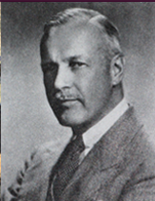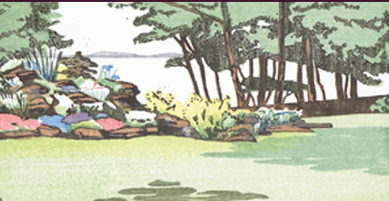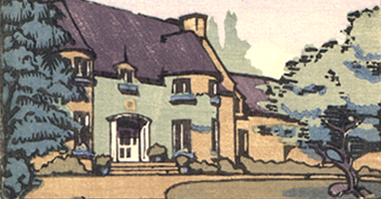 |
|
|||||||||||||||
|
|
 |
|
 |
|
||||||||||||
 |
|
|
||||||||||||||
|
|
|
|||||||||||||||
|
|
|
|
|
|
||||||||||||
|
|
|
|
|
|
|
|
|
|
|
|
|
|||||
|
|
|
|
||||||||||||||
|
|
|
|
|
|
|
|||||||||||
|
|
|
|
|
|
|
|
|
|
|
|
|
|
|
|
|
|
Introducing F. Cleveland Morgan
As member of the third generation of one of Montreal’s prominent mercantile families, F. Cleveland Morgan (1881-1962) enjoyed both the leisure and the wealth to support his commitment to cultural philanthropy. supporting Montreal institutions, especially the Art Association, (now the Montreal Museum of fine Arts), McGill University, and the Canadian Handicraft Guild,. Morgan’s involvement with the Montreal Museum was life-long: he served as its president, and as a member of both its hanging committee and its board. Perhaps his greatest legacy was his influence was on the unique way in which its collections developed during the five decades during which he was effectively its non-stipendiary curator of decorative arts.
Le Sabot, built as a country retreat for Morganand his family in 1912, is one of the outstanding examples of an arts and crafts movement domestic architecture in this country. Designed by Scottish immigrant architect David Shennan, Le Sabot was at the time of its construction one of the more innovative of the country homes found along the shores of the Lac-des- Deux-Montagnes in Senneville on the Island of Montreal. Today, still the home of the third generation of Morgan’s descendants, it remains furnished very much as it was in his lifetime. Remarkably informal considering its size, its interior is full of natural light and oriented to views of the surrounding gardens, and continues to offer visitors a unique insight into the aesthetic vision of F. Cleveland Morgan.
This website offers researchers an introduction to a selection of primary documents relating to the life and collecting activities of F. Cleveland Morgan, one of the most gifted Canadian connoisseurs of his generation.
Biography:
F. Cleveland Morgan ranks with such distinguished Canadian collectors - philanthropists as Lord Beaverbrook, Alfred Beder, Michael Hornstein, Vincent Massey, Ken Thompson, Cornelius van Horne, and the Tannenbaum family. His contribution to the cultural life of Montreal is often overlooked, yet few individuals have made such a significant contribution to institutions such as the Montreal Museum of Fine Arts, the McCord Museum, and the collections of McGill University.
Henry Morgan and Company was one of the first and most prestigious department stores in Canada. Originally located in old Montreal, it eventually relocated facing the Art Association across Phillips Square. The store opened an art department in 1900, when James Morgan offered space to for the inaugural exhibition of the Canadian Handicraft Guild. Cleveland would later acquire items from this fifth floor Gallery at Morgan's, which was later known as "Colonial House". These would include contemporary studio pottery, antique furniture and eighteenth century paintings, most of which in time entered the Museum collection, although some remain at Le Sabot, and Cleveland's children would shop for Christmas presents for their father at the Morgan's Gallery.
The Morgan family was interested in the visual arts, and keen supporters of the Montreal Art Association, which later became the Montreal Museum of Fine Arts. James, Cleveland's father, was an amateur painter and collector, an early patron of Clarence Gagnon and a friend of William Brymner, director of the Art Association's school. Cleveland was a cousin of painter John Lyman, and a friend of numerous artists and architects active in Montreal during his lifetime. As a child, Cleveland made numerous trips to Europe with his family, and it was during these that he first purchased antiquities and works of art, as well as visiting museums and historic sites. These early trips formed a life-long habit. An inveterate record keeper, Morgan's life-long habit of keeping journals, writing letters and detailed records of his acquisitions, offer a thorough archival record of his passionate commitment to the arts.
Following his undergraduate studies at Cambridge, Cleveland Morgan had returned to Montreal. Abandoning his studies at McGill for reasons of health, he entered the family business in 1904. In 106 he married Elizabeth Marcia Shaw, known as Bessie, then a student at Wellesley College. They settled in a home at 308 Peel Street, (now demolished), a wedding present from Bessie's parents, where they soon had three children. Cleveland joined the Art Association in 1907, and served in a variety of capacities. He was appointed a member of the hanging committee in 1915, and later served as its President, but his most significant role was as curator of the decorative arts collections for forty-six years from 1916 until his death in 1964. This was a voluntary position and for much of that time half of each working day was spent at the Museum. During this period more than seven thousand objects were acquired for the collection. Of these 600 were donated by Morgan during his lifetime, with an additional 450 objects presented by his estate. As well, during the hard financial era of the 1930's, Morgan sold another part of his collection which he had hoped would eventually go to the Museum to Mabel Molson, who in turn donated them to the collection.
Unlike many American and continental European fine arts museums, most Canadian public art collections have traditionally focused on fine art narrowly defined as painting, the graphic arts, and sculpture. In 1919 Cleveland Morgan challenged this when he obtained the endorsement of the Art Association to form a museum collection. He would later recall…“I suggested to Council starting a collection of decorative Arts as an interesting adjunct to the Picture Collections. I was assigned an empty room on the strictest understanding that I was to expect no money for cases or objects.” His object was the “study of the history of the world; of the customs, manners & philosophies of peoples” through the objects made by all cultures. At a time when objects made by tribal peoples could be seen, if it all, in Ethnographic museums concerned only with the utilitarian functions, Cleveland Morgan together with a handful of vanguard connoisseurs were leaning to appreciate their aesthetic sophistication. While his collecting activity was very comprehensive, the can be no doubt that he was particularly attracted to the art of specific cultures.
He was also a generous donor and advisor to both the McCord Museum and the Rare Books collection of the McGill University Library. Morgan was an early supporter of the Canadian Handicraft Guild, serving as its president and playing an active role in the formation of its outstanding collections. He was appointed a Trustee of the National Gallery of Canada in 1952, but resigned in 1959 to protest the interference of the Diefenbaker government in the acquisition of pictures from the Liechtenstein royal collection. Morgan cultivated a wide network of dealers, and was in a position to seek advice from advisors including Bernard Berenson, Anthony Blunt, Kenneth Clark, Sir John Pope-Hennessey and Paul Sachs, during his frequent travels.
Le Sabot and Senneville
In 1893 Cleveland Morgan’s parents had purchased a twenty-acre property at Senneville. There they built a summer home which they named Graystanes. Their neighbors in Senneville included R.B. Angus and Senator Louis-Joseph Forget, whose homes were designed by the Maxwell brothers. Another neighbor was Sir Edward Clouston, whose residence Boisbriant was nearby, and whose daughter and her husband Dr. J. L. Todd built a house designed by Percy Nobbs during 1911-1912. Like the Todds, Cleveland Morgan began to plan a Senneville home during this same period, turning to a compatriot of Nobbs' for its design. At that time James Morgan began an ambitious project of restoring and enlarging a home in Bermuda, where he retired. Perhaps this impending move meant that Cleveland and his young family would no longer have access to the site of his own cherished childhood summer memories and led to the purchase of the adjoining property.
The architect of Le Sabot, David Shennan, was born in Scotland in 1880, and apprenticed to architect John Alexander Macgregor of Castle Douglas between the years 1896-1899. Shennan then moved to Sterling to work with the firm of McLukie and Walker, and in 1904 moved again to serve James Marshall as chief assistant in Perth. Shennan immigrated to Montreal in 1906, where he worked for Charles Saxe and John Archibald as an assistant, and was soon promoted to serve as their chief assistant. At the time of the Morgan commission Shennan lived at 86 Green Avenue in Westmount. He served in the armed forces during the First World War, and was later elected to the Royal Canadian Academy. Shennan’s subsequent career focused on hotel design. He was the designer of the Manoir Richelieu, the Hotel Tadoussac, and the Thousand Islands Club, all built for the Canada Steamship Lines. He also worked on the design of the Hotel Bessborough in Saskatoon, the Chateau Laurier in Ottawa.
The influential Scottish-born architects Ramsey Traquir (1874-1953) and Percy Nobbs (1875-1964) were Shennan's compatriots and contemporaries. Both were active in the Art Association and also friends of Morgan's. Nobbs wrote an article in the American edition of Country Life in 1923, entitled "Developments in Canadian Architecture" which described the Morgan country house as "a splendid example of the real Canadian type of Architecture. In it are combined the best elements of early Canadian Tradition with the most modern developments in domestic architecture." Traquair was a frequent visitor to Le Sabot and was commissioned by Morgan to make two colored wood-cuts depicting the house and its gardens. Beyond their common ancestry and British educations, Shennan, Nobbs, Traquair and Morgan shared a deep interest in the Arts and Crafts movement commitment to the appreciation and fostering of traditional vernacular building and furniture, working together to create an appreciation of the traditional arts and architecture of Quebec.
Gardens
Although Cleveland Morgan had been forced for medical reasons to abandon his original intention to pursue an academic career in biology, he retained a life-long interest in horticulture. A respected member of numerous international societies, he was known as a talented developer of new hybrids especially in his specialty areas of iris and orchid cultivation. The gardens surrounding Le Sabot, which he designed, quickly attracted the attention of garden periodicals and photographs were frequently published of its rock gardens, and its distinctive Arts and Crafts architectural elements which included a dovecote and a stone and wrought iron wellhead, it made sensitive use of the terrain and possibilities of the local climate. By the 1920's it was planted with more than 500 plant species and in included a spring garden, a bowling green, an orchard, as well as alpine and rose gardens, areas devoted to Japanese iris and peonies, and herbaceous borders lining an extensive system of paths. Both the gardens and the Arboretum across the road contained numerous unusual trees. In Morgan's day a team of nine gardeners worked on the gardens and in the nearby greenhouses, were new plant species were developed.
Cleveland Morgan was a major contributor to the development of the adjoining family-owned lands today know as the Morgan Arboretum. A large portion of this land had originally been purchased in the nineteenth century from Sir George Abbott. In 1945 the Morgan family presented 350 acres to McGill University. An additional adjoining 250 acres were gifted by J. W. McConnell, making the Morgan Arboretum the largest green space on the Island of Montreal.
Bruce Russell
(with thanks to Janet Brook and Alexander Reford)